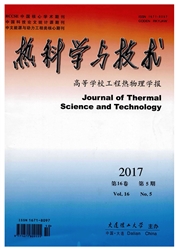

 中文摘要:
中文摘要:
基于Brinkman-Darcy模型和两方程模型,对流体在金属泡沫平板通道内的强制对流传热进行了自编程数值模拟,采用体积平均法对流体在金属泡沫内的流动和传热进行宏观处理。模拟结果表明:流体主流速度随孔密度增大而减小,随孔隙率增大而增大;流体相和固体相之间的局部对流传热系数随孔隙率和孔密度增加而增加,金属泡沫对流传热性能随孔隙率增大而减小,随孔密度增大而增大。金属泡沫强化传热的效果十分明显,可以应用于需要强化传热的紧凑式换热器和散热器。
 英文摘要:
英文摘要:
Based on the Brinkman-Darcy model and two-equation model, the forced convective heat transfer in metal-foam parallel-plates was numerically studied using an in-house CFD code. Macroscopic flows and heat transfer of fluid in metal foams were treated with a volume-averaging method. With a decrease in pore density or an increase in porosity, the main fluid velocity increase. The local convective heat transfer coefficients of solid and fluid phases increase with an increase in porosity or pore density. The overall thermal resistance for convection in metal foams decreases with an increase in porosity but increases with an increase in pore density. Metal foams have an obvious heat transfer enhancement effect, which can be used for compact heat exchangers and heat sinks requiring heat transfer enhancement.
 同期刊论文项目
同期刊论文项目
 同项目期刊论文
同项目期刊论文
 期刊信息
期刊信息
